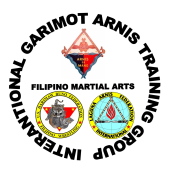HISTORY

Garimot Arnis Training is a Filipino Martial Arts practiced traditionally on the Baet family for more than 170 years old. From small town called Paete, Laguna Philippines the arts of the Garimot Arnis was born. The Baet family is widely known Moro-moro players called Doce Pares in Laguna way back in early 1800's. For more than five generation, tradition has been passed from one generation to the next. Doce Pares de Francia or the show Comedia or Zarzuela serves as vehicle to shroud the arts of Arnis de Mano the Filipino martial arts of hand to hand fighting utilizing blades and sticks fighting arts and more. The history dictates the Filipino combat arts was banned on 1610 by the Spanish authority to stop the chances of Filipino practicing their arts of war that could be used against Spanish authority, to stop the native to practicing the arts, they forbids the practiced of the fighting arts. But on 1637 Doce Pares was introduced in Luzon via galleon Acapulco-Manila. It was the Spanish Fray from Mexico introduced the Doce Pares de Francia then later Filipino changed the name into famous Moro-moro stage shows. Today the original Doce Pares de Francia or Moro-moro is alive and taught by Gat Puno Abon "Garimot" Baet, 5th generation Maestro from Laguna, Philippines
GARIMOT ARNIS LOGO

Arnis de Mano is a vigorous sport which requires and develops stamina, quick
reactions, speed, accuracy, and excellent coordination. Arnis de Mano serves as an
umbrella title for the seven major combative arts of the Philippines:
Laban Baston (Stick Fighting) - (single and double stick)
Laban Tabak (Sword Fighting) [including espada y daga]
Laban Daga (Knife Fighting) (including Balisong Manipulation Theory)
Laban Kamay (Hand to Hand Fighting) (Mano-mano)
Laban Sipa (Foot Fighting) (Sikaran)
Laban Buno (Grappling Arts) (ground fighting)
Garimot Hilot (Healing Arts) (accupressure massage)
Arnis is very much a mental game as well as physical. The cerebral aspects of the sport are highlighted as one attempts to quickly analyze the adversary's style while devising a means by which to counter it. In addition to analytical thinking, Arnis requires decisive thinking and the courage to assume the offensive when the opportunity presents itself. Good sportsmanship is an integral part of the Arnis tradition. Arnis was for many years considered a sport for gentlemen only and participants were expected to conduct themselves accordingly. Much of this "flavor" still exists today. Arnis de mano has been proven in combat throughout the many wars in Philippine history and is held in high regard by law enforcement officers around the world. The serious student will find the knowledge and skill gained through consistent and dedicated practice an invaluable addition to an existing martial arts repertoire.


